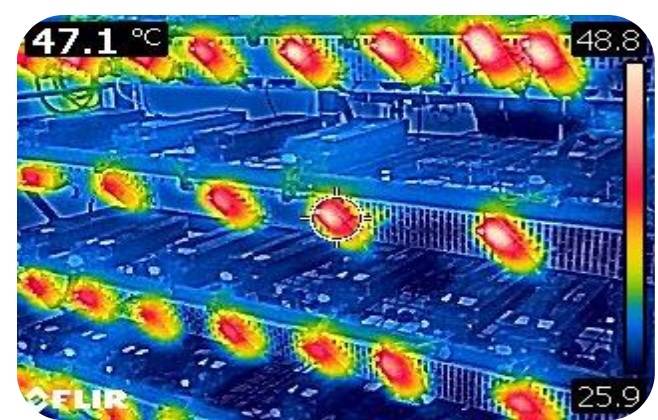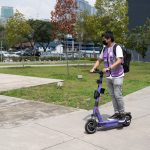Beam Mobility Leads the Charge in Micromobility Battery Safety With Innovative Thermographic Battery Management

E-bikes and e-scooters offer a fast and efficient way to get around. But they come with a risk common to all products that use lithium ion batteries: fire. That risk extends to products used in everyday life, like smartphones or laptops. For shared e-scooters and e-bikes that are openly available to the public, the risk is even greater because the batteries have a lot of concentrated power (15x your typical laptop), and they’re exposed to harsh conditions like severe weather, such extreme temperatures and flooding or public vandalism. In 2021, Beam Mobility decided to take strategic action to reduce that risk. The result is an efficient system called the BeamSafe Thermal Monitoring System.
Shared micromobility devices have gotten extremely popular with over a billion trips taken globally in the past year. Beam operates over 70,000 vehicles, and to reduce the environmental and economical cost of keeping vehicles charged, Beam Mobility uses 100% swappable batteries where only discharged batteries are brought back to a charging facility. Safe transport, charging, design and use of these batteries is no easy task, but Beam’s Hardware, Health, Safety, Quality, and Environment (HSEQ) and Facilities management have built dozens of safety protocols and industry-leading technology to keep our staff and the public safe. Beam’s batteries are among the most durable out there with the highest global standard of certification, known as UL2271. That means the batteries have been pushed to the limits – they’ve been dropped from heights, short-circuited, and submerged underwater during testing.
Even though many fires and injuries go unreported, in the U.S. alone, there were over 250,000 overheating and fire incidents from 2017 to 2022 reported and 147 injuries and deaths in New York City alone in 2022.
“Beam has not had any injuries to date from vehicle battery fires due to its extreme testing of batteries, expertly designed HSEQ policies, built-for-safety facilities and most recently its BeamSafe Thermal Monitoring System, which has won and been nominated for several facilities management and safety awards this year” – Deb Gangopadhyay, President of Beam.
Why Lithium Ion Batteries Sometimes Fail
Lithium ion batteries are used in many everyday items — not just micromobility devices. They’re found in smartphones, laptops, and many power tools. They’re also used in electric cars and trucks. However, there is a risk of fire if a lithium ion battery’s integrity is compromised.
Most lithium ion batteries operate on multiple cells. If a single cell fails, it causes heat to build up within the device. The heat can act as a catalyst for further battery cell damage, known as thermal runaway. If not caught quickly, the battery may emit toxic fumes and spark a dangerous fire. To catch this in advance, Beam’s scooters have a battery management system that runs hundreds of checks at high frequency to detect and immediately flag any anomalies to our operations system via cellular signal.
One of the riskiest parts of handling the batteries isn’t actually when they’re inside the e-scooter, but when they’re charging at a charging facility. That makes it critical for companies to carefully design tools to mitigate the risk of battery failure and identify it before it becomes destructive.
Enter the BeamSafe Thermal Monitoring System.

How Beam Mobility’s Thermal Monitoring System Eliminates Battery Failure Risk
As a company that operates in a swiftly growing, pioneering industry, Beam Mobility takes safety incredibly seriously. To mitigate the risk of battery failure, it appointed a facilities management expert to oversee the creation of a cutting-edge system designed to catch battery failures early. The result was the BeamSafe Thermal Monitoring System.
The BeamSafe Thermal Monitoring System combines hardware and mobile applications to monitor its lithium batteries. It uses state-of-the-art thermal cameras that monitor battery temperature with an infrared heat map. If temperatures rise above a specific amount, it triggers an automatic alert to the Beam operations team and monitoring service. The team can take quick preventative action, including contacting emergency services.
Every Beam charging station is custom-built, giving the company full control over its infrastructure. All charging racks include features that promote adequate air ventilation. Cables used to connect the charging racks and power rails include circuit breakers to prevent surges and facilitate even power distribution. An emergency stop system is built into the rack with push buttons installed to the warehouse near entry/exit points that will cut power to charging racks in the event of an emergency.
Beam continues to strengthen and optimize its Thermal Monitoring System. Every month, its team holds testing across all devices and charging racks to evaluate battery health. It also uses an offsite monitoring center that reviews camera feeds and other data for potential battery problems. The monitoring center operates all hours of the day, detecting battery anomalies before they escalate.
The Path Forward: Enhanced Lithium Ion Battery Protections
Beam Mobility’s advancements toward improved lithium ion battery safety are important to the communities in which it operates and for the industry at large. Beam regularly works with local governments throughout Australia and New Zealand on matters concerning the micromobility industry, including battery safety. As e-scooters and e-bikes gain traction among consumers, Beam Mobility aims to be a beacon for safe operations. Beam plans to continue innovating and refining solutions to improve all aspects of safe lithium-ion battery management. For instance, Beam is working with its partners to develop a smart, internet-connected battery charger that can detect charging anomalies and automatically take action.
Beam Mobility is the largest micromobility operator in Australia. Its e-scooters, e-bikes, and e-mopeds are available throughout APAC, including Australia, New Zealand, Malaysia, South Korea, and Türkiye.

